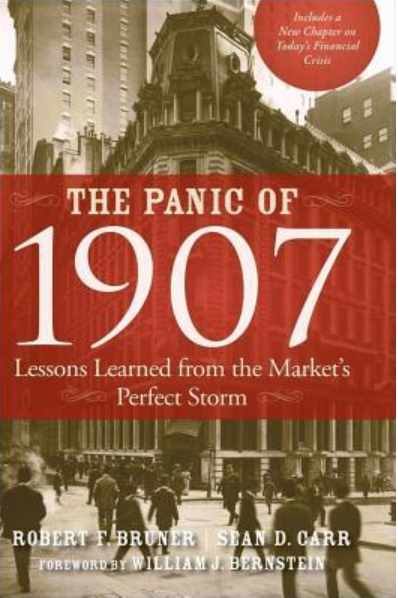The Panic of 1907: Lessons Learned from the Market’s Perfect Storm by Robert F. Bruner

Chapter 1
Wall Street Oligarchs
A man I do not trust could not get money from me on all the bonds in
Christendom.
—J. Pierpont Morgan
In 1907, the young American economy was roaring. Between the mid-
1890s and the end of 1906, the nation’s annual growth rate was a stunning
7.3 percent, which had doubled the absolute size of all U.S. industrial
production during a relatively brief period. The volatility of this growth also
leaped from just over 6.5 percent to 8.0 percent per year—although, relative
to the high rate of growth, this economic volatility was slightly lower than
what it had been during much of the nineteenth century. Even so, compared
with previous periods of major industrial expansion, the U.S. economy in
1907 was larger and growing faster than ever (see Figure 1.1).
With the dramatic growth and economic development of the United
States at the turn of the century came an enormous demand for capital. In
1895 the U.S. economy added $2.5 billion to its fixed plant and inventories,
and by 1906 the annual rate of capital formation was running at nearly $5
billion, a blistering pace (see Figure 1.2). Much of this was financed by the
country’s exports, which appeared as a bulging current account surplus after
1895. But even exports were insufficient to finance the very large growth
rate in the formation of capital in 1905 (12.7%) and 1906 (21.8%).
Figure 1.1 Comparative size, growth, and volatility of U.S. industrial
production.
NOTE: The size of the circles indicates the relative size of the U.S.
industrial production at 1864, 1893, and 1907 respectively. The growth rate
is the compound average over each period. The coefficient of variation is a
measure of relative volatility of growth (calculated as the standard deviation
of growth rates divided by the compound average rate of growth for the
period).
SOURCE: Authors’ figure based on data from NBER, David Industrial
Production Index.
Into this prodigious vacuum moved a tightly knit network of financiers in
New York and London who possessed the sophistication and credibility to
raise the necessary funds for America’s factories and infrastructure in the
world’s capital markets. Their success in attracting foreign capital to
America’s “emerging market” was reflected in the immense importations of
gold in 1906: the inflow of gold to the United States spiked sharply upward
to $165 million, dwarfing all gold flows after the Civil War, except during
the year of a significant economic downturn in 1893.
Figure 1.2 Macroeconomic trends, 1895 to 1913.
SOURCE: Authors’ figure based on data from NBER Macro History
Database.
The Panic of 1907: Lessons Learned from the Market’s Perfect Storm by Robert F. Bruner




